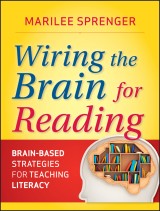Details

Wiring the Brain for Reading
Brain-Based Strategies for Teaching Literacy1. Aufl.
|
18,99 € |
|
| Verlag: | Wiley |
| Format: | |
| Veröffentl.: | 07.03.2013 |
| ISBN/EAN: | 9781118220542 |
| Sprache: | englisch |
| Anzahl Seiten: | 224 |
DRM-geschütztes eBook, Sie benötigen z.B. Adobe Digital Editions und eine Adobe ID zum Lesen.
Beschreibungen
<b>Using the latest neuroscience research to enhance literacy instruction</b> <p><i>Wiring the Brain for Reading</i> introduces teachers to aspects of the brain's functions that are essential to language and reading development. Marilee Sprenger, a specialist in learning and the brain, provides practical, <i>brain friendly</i>, strategies for teaching essential skills like phonemic awareness, phonics, fluency, vocabulary, and comprehension. The author's innovative approach aligns well with the Common Core State Standards for English Language Arts and is designed to enhance students' motivation and excitement in reading.</p> <ul> <li>Offers a clear explanation of brain functioning in order to enhance language and reading instruction</li> <li>Incorporates proven literacy strategies, games, and activities as well as classroom examples</li> <li>Aligns with Common Core State Standards for learning to read, developing fluency, and interpreting complex texts</li> </ul> <p><i>Wiring the Brain for Reading</i> offers practical strategies for applying the latest research in neuroscience and learning to the classroom.</p>
<p>Acknowledgments ix</p> <p>About the Author xi</p> <p>About the Book xiii</p> <p><b>CHAPTER 1 Language Development 1</b></p> <p>From Neural Sensitivity to Neural Commitment 2</p> <p>The Right Way to Babble 4</p> <p>Encouraging Speech 5</p> <p>Windows of Opportunity 8</p> <p>Experience and Brain Development 9</p> <p>Ages and Stages in Language Development 11</p> <p>An Enriched Environment for Language Development 13</p> <p>Language and Gender 16</p> <p>Speaking Out of Both Sides of the Brain 18</p> <p>Activities 20</p> <p>Summary 23</p> <p><b>CHAPTER 2 Imaging and Imagining the Brain 25</b></p> <p>The Structure of the Brain 26</p> <p>How We See the Brain 29</p> <p>Brain Cells 32</p> <p>How Cells Communicate 35</p> <p>What We Thought We Knew 37</p> <p>What We Found Out Along the Way 38</p> <p>Two Diverging Roads 40</p> <p>Learning and Memory: A Definition 43</p> <p>Summary 46</p> <p><b>CHAPTER 3 The Body-Brain Connection 47</b></p> <p>Food, Glorious Food! 48</p> <p>The Learning Brain’s Diet 54</p> <p>To Sleep; Perchance to Remember 57</p> <p>Making the Right Moves 62</p> <p>Sunshine Came Softly Through My Window 64</p> <p>Brain-Body Basics 65</p> <p>Stress Can Hurt the Body and the Brain 68</p> <p>What Does Bullying Do to the Brain? 71</p> <p>Summary 72</p> <p><b>CHAPTER 4 Breaking the Code 75</b></p> <p>Phonemic Awareness 78</p> <p>The ABCs of the ABCs 82</p> <p>Mirror, Mirror 82</p> <p>Neurons That Fire Together 83</p> <p>Dr. Seuss and Mother Goose? 84</p> <p>Getting to the Core 85</p> <p>Teaching Phonemic Awareness 87</p> <p>Activities 87</p> <p>Summary 95</p> <p><b>CHAPTER 5 Patterns and Programs and Phonics! Oh, My!</b> <b>97</b></p> <p>Patterns and Programs 98</p> <p>The Alphabetic Principle 102</p> <p>One to One? Not Exactly 103</p> <p>The Common Core: Where Do We Stand with the Standards? 103</p> <p>Decoding Development in the Brain 104</p> <p>Phonics Instruction 107</p> <p>Factors That Lead to Learning 108</p> <p>Eenie, Meenie, Minee, Moe. Or Is It Eeny, Meany, Miny, Mo? 109</p> <p>Activities 111</p> <p>Summary 113</p> <p><b>CHAPTER 6 The Fluent Reader 115</b></p> <p>What Fluency Means 117</p> <p>The Brain’s Pathway to Fluency 119</p> <p>Reading Is Pleasure 120</p> <p>High-Frequency and Sight Words 121</p> <p>Some Steps to Fluency 122</p> <p>Activities 125</p> <p>Summary 127</p> <p><b>CHAPTER 7 Building Vocabulary 129</b></p> <p>Two Types of Vocabulary 130</p> <p>Vocabulary Development 131</p> <p>The Common Core State Standards and Vocabulary 132</p> <p>The Common Core College and Career Readiness Anchor Standards for Language 134</p> <p>Choosing Our Words Carefully 135</p> <p>Activities 139</p> <p>Summary 143</p> <p><b>CHAPTER 8 Comprehension 145</b></p> <p>Modeling Comprehension 147</p> <p>Comprehension Strategies 149</p> <p>Before, During, and After Reading: What These Strategies Have to Do with the Brain 158</p> <p>Activities 161</p> <p>Summary 186</p> <p><b>CHAPTER 9 Putting It All Together 187</b></p> <p>For Parents 187</p> <p>For Teachers 188</p> <p>Keep Learning About the Brain 189</p> <p>References 191</p> <p>Index 201</p>
<p><b>Marilee Sprenger</b> is an independent educational consultant. She consults and presents nationally on topics of learning, memory, differentiated instruction, and brain-based teaching practices. A former teacher, she is an adjunct professor at Aurora University. Often known as the "Brainlady," she is affiliated with both the American Academy of Neurology and the Learning and the Brain Society and is the author of several books on the brain and learning.</p>
<p>Teaching reading skills can be challenging for any teacher or parent. In <i>Wiring the Brain for Reading</i>, reading expert Marilee Sprenger introduces readers to the specific neural connections that are most relevant to language and reading development and shows how these reading pathways can best be nurtured, even in children who struggle with reading. The book is filled with practical, 'brain friendly' instructional strategies, games, and activities that are designed to be easily implemented. <i>Wiring the Brain for Reading</i> highlights the following topics:</p> <ul> <li>The neural connections necessary for learning to read</li> <li>The importance of the body-brain connection</li> <li>Building phonemic awareness and decoding skills</li> <li>Brain-based techniques for developing vocabulary and building fluency</li> <li>Memory strategies to reinforce comprehension</li> </ul> <p>By putting the emphasis on phonemic awareness, phonics, fluency, vocabulary, and comprehension, Sprenger's approach aligns with research-based reading instruction and Common Core standards, and is designed to enhance students' motivation and excitement in reading.</p> <p><b>Praise for <i>Wiring the Brain for Reading</i></b></p> <p>"Exceptional background on reading and exceptional practical suggestions. A must read for anyone who teaches reading, works with parents, or teaches teachers. Highly recommended!"<br /> <b>—Eric Jensen</b>, author, <i>Teaching with the Brain in Mind</i></p> <p>"Marilee Sprenger presents a fine book that provides useful nontechnical information on the neurobiology and pedagogy of reading. Sprenger doesn't view reading as a mere visual phenomenon, but rather as an enjoyable experience that encompasses our entire body and brain."<br /> <b>—Robert Sylwester</b>, Emeritus Professor of Education, University of Oregon</p> <p>"Marilee has captured the literature from beginning to end in a comprehensive review that will provide the basis for exploring reading practices as supported with a 'neuro-lens'"<br /> <b>—Bob Greenleaf</b>, president, Greenleaf Learning</p>


















